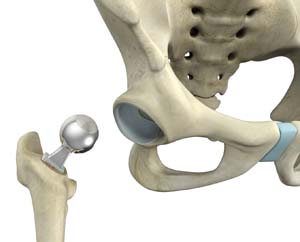Hip Hemiarthroplasty Surgeon in Fort Worth, TX
Patients with hip fractures are treated with a surgical technique called hip hemiarthroplasty, wherein only one half (ball section) of the hip joint is substituted by a metal prosthesis. Dr. Moore provides expert diagnosis and individualized treatment plans for hip fractures including hemiarthroplasty in Fort Worth, TX. Dr. Moore also provides highly specialized care during and after surgery. Contact Dr. Moore’s team for an appointment today!

What is Hip Hemiarthroplasty?
Hip hemiarthroplasty is a surgical technique employed to treat hip fractures. In this procedure, only one half (ball section) of the hip joint is substituted by a metal prosthesis.
The hip joint is one of the body's largest weight-bearing joints and is the point where the thigh bone (femur) and the pelvis (acetabulum) unite. It is a ball and socket joint in which the head of the femur is the ball and the pelvic acetabulum forms the socket. The joint surface is covered by smooth articular cartilage that cushions and enables smooth movements of the joint.
Surgical procedure
The procedure is performed under general anesthesia. An incision is made along the outer aspect of the affected hip. Your surgeon gains access to the hip joint and the head of the femur is removed using surgical instruments and prepared to accept the prosthesis. The stem of the metal prosthesis is placed inside the femoral bone. The surgeon now connects the metal ball that forms the femoral head. The stem prosthesis can be press-fit in patients with a strong, healthy bone or cemented in cases of weak, osteoporotic bone. The method of implantation depends on the patient’s age and condition of the bone. At the end of the procedure, the incisions are closed with sutures and a dressing is applied.
After surgery
The post-procedural instructions to be followed hip hemiarthroplasty include:
- You will be prescribed medications to reduce pain and inflammation
- Crossing your legs should be avoided
- Avoid lifting of heavy objects
- Avoid bending and twisting your hip. Instead, use grabbers to pick things
- Avoid standing for long hours
- Use an elevated toilet seat
- Avoid sitting on low chairs
Your surgeon may recommend physical therapy to strengthen the joint and the muscles and to help restore mobility to the hip joint.
Complications of hip hemiarthroplasty include infection, dislocation, deep vein thrombosis, loosening of the prosthesis, and failure to relieve pain. Discuss with your surgeon if you have concerns regarding hip hemiarthroplasty surgery.
If you would like to have additional information on the treatment of hip fractures or would like to learn more about hip hemiarthroplasty, please contact Dr. Moore, serving the communities of Fort Worth, TX.






